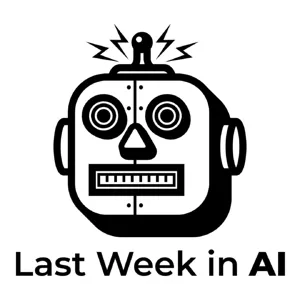Podcast Summary
AI systems don't truly understand the content they generate: Despite generating human-like text, AI lacks understanding and could lead to an overwhelming amount of 'bullshit' content.
While AI systems like Chat GPT can generate human-like text with impressive accuracy, they don't actually understand the content they're producing. They synthesize responses by predicting the next word in a sentence based on patterns learned from vast amounts of text data. This can result in plausible-sounding answers, but they don't have a true understanding of the concepts they're discussing. Gary Marcus, a leading voice in AI skepticism, argues that this lack of understanding poses a problem as we drive the cost of producing AI-generated content to zero. The persuasiveness and flexibility of these systems could lead to an overwhelming amount of "bullshit" - content that has no real relationship to the truth. As we continue to explore the capabilities of AI, it's important to remember that these systems don't actually understand what they're saying or doing, and we should approach their outputs with a critical eye.
Humans vs. GPT-3: Understanding vs. Pastiche: Humans build internal models of the world based on experiences and knowledge, while GPT-3 just combines phrases without true understanding.
While GPT-3, the technology behind ChatGPT, excels at pastiche by cutting and pasting and imitating styles, it doesn't truly understand the connections between ideas. It's like a human being who, when discussing complex topics, relies on their internal models and knowledge, rather than just averaging or pastiche. However, this discussion raised an interesting question: aren't humans also "kings of pastiche"? We may not fully understand everything we talk about, but we do build internal models of the world based on our experiences and knowledge. GPT-3, on the other hand, simply puts together text without understanding the meaning. It's important to remember that understanding involves more than just combining phrases; it also involves interpreting intentions and indirect meanings. So while GPT-3 may be a master of pastiche, it's still a long way from truly understanding the world like humans do.
Neural networks aren't as complex as the human brain: Despite improving in specific areas, neural networks don't have deep understanding or reliability, contradicting the belief that larger systems will lead to general intelligence.
While neural networks, such as those built by OpenAI, can be seen as energy flowing through a network, they do not function in the same complex and structured way as the human brain. The belief that making these systems larger with more data will lead to general intelligence, often referred to as "Moore's Law for Everything," is a misconception. Neural networks can improve in certain areas, like language processing, but they are not making significant progress towards truthfulness and reliability, which are crucial for achieving artificial general intelligence. The current systems are not reliable or truthful, as Sam Altman, the CEO of OpenAI, was forced to admit after the initial excitement about ChatGPT. These systems are not capable of having a deep understanding of the world and are simply trying to auto-complete sentences, making it mystical to think otherwise. The goal should be to create systems that have more comprehension and can accurately represent truth.
AI's Indifference to Truth and the Danger of Misinformation: AI models can generate misinformation by disregarding truth, making it difficult to distinguish fact from fiction, and posing a significant threat to society.
While advanced AI models like Chachi PT and GPT-3 can generate impressive and often accurate responses, they lack a fundamental understanding of truth and operate by synthesizing and pastiching existing information. This can lead to a concerning proliferation of misinformation, as these systems can generate convincing but false narratives, making it increasingly difficult to distinguish truth from bullshit. Harry Frankfurt's philosophy paper on the subject explains that bullshit is not necessarily false but phony, and its danger lies in its indifference to the truth. The potential implications of this are significant, as the cost of producing and disseminating misinformation could reach zero, leading to a tidal wave of potential misinformation that could threaten the fabric of society. This is not just a theoretical concern; we've already seen instances of this with the use of AI to generate false answers on Stack Overflow. Developing new AI technologies to detect and counteract this misinformation is crucial to mitigate these risks.
The Challenge of Discernment in the Age of AI-Generated Content: As AI systems generate increasingly convincing content, it becomes harder for individuals to discern fact from fiction, potentially leading to widespread distrust and legal issues. We need to find ways to navigate this new landscape of information.
As we increasingly rely on AI systems like ChatGPT for information, the potential for misinformation and the inability to discern fact from fiction becomes a significant concern. The scale and plausibility of AI-generated content make it more challenging for individuals to judge the authenticity of information, potentially leading to widespread distrust and even lawsuits. The issue is not just about AI systems being held to a higher standard than society itself, but also about the difference in scale and plausibility compared to traditional misinformation. While we have some practices for evaluating the legitimacy of websites and sources, the uniformity and authority of AI-generated content may lead people to assume it's all true or false by default. The potential threat to both websites and search engines themselves is a serious concern. It's important to remember that AI systems are currently capable of generating stylistically convincing content, and we need to find ways to navigate this new landscape of information.
AI-generated content can create persuasive, targeted content with little truth value: AI language models like GPT-3 can generate stylistically flexible content, posing a risk for personalized propaganda, misinformation, or spam. Revenue model based on search engine optimization worsens the issue of misleading content online.
The advancements in AI-generated content, specifically language models like GPT-3, have the potential to create highly persuasive, targeted content with little to no truth value. This is concerning as these technologies can be used for personalized propaganda, misinformation, or even spam. The ability to create stylistically flexible content without an internal understanding or morality is particularly valuable for advertising-based businesses, where the goal is to get users to take a desired action, rather than prioritizing truthfulness or accuracy. The revenue model for these models is largely based on search engine optimization, leading to the creation of hoax websites that exist solely to sell ads. This trend has the potential to significantly worsen the issue of misleading or irrelevant content on the internet, making it even more challenging for users to discern truth from fiction.
Challenges of Misinformation and Large Language Models: Despite growing size, large language models may not increase trustworthiness or comprehension abilities, contributing to a 'shadow economy' of misinformation in the digital world.
The digital world is facing a significant challenge with the proliferation of fake websites and large language models contributing to the creation and dissemination of misinformation. These entities exist primarily to sell ads and manipulate search engine algorithms, leading to a "shadow economy." However, a 2022 paper from Google revealed that making these language models larger does not necessarily increase their trustworthiness or ability to understand larger pieces of text. This is a concerning development as these models are increasingly being used to generate content and answer queries. The industry is only beginning to recognize the seriousness of this issue, and more research is needed to develop effective benchmarks for evaluating truthfulness and comprehension. Despite these challenges, there is an optimistic view that as these models continue to grow, they may also advance knowledge and create innovative content. However, it is crucial to address the issues of misinformation and comprehension limitations to ensure the accuracy and reliability of the information generated by these models.
AI systems struggle with complex context and consequences: AI systems like ChatGPT can generate responses, but lack a deep understanding of complex context and consequences, leading to superficial responses and guardrails.
While AI systems like ChatGPT have made significant strides, they still face challenges in understanding complex context and consequences. The example of a children's story about a lost wallet illustrates this, as the system struggles to understand the difference between finding different amounts of money. The system also fails to grasp the meaning of words like "unwittingly" in a four-paragraph essay. Additionally, the system's guardrails can sometimes be excessive, as shown in its inability to predict the gender or religion of hypothetical first presidents. The key issue is that these systems lack a deep understanding of the world, leading to superficial responses and guardrails. Despite these challenges, the potential benefits of creating intelligent artificial systems are significant and positive. The speaker, who has a background in AI, emphasizes the importance of improving these systems and ensuring they truly understand the world to avoid potential dangers and misunderstandings.
Focusing too much on pattern recognition in AI research: We need a more holistic approach to AI research, incorporating a broader understanding of cognitive science and human intelligence, to create transformative advances in various fields and ensure alignment with human values.
While deep learning and AI have shown great promise, particularly in areas like pattern recognition, the field is currently overly focused on this one aspect of cognitive science. The human mind is complex and multifaceted, involving not just pattern recognition but also language use, analogy making, planning, and more. By ignoring these other aspects, we risk creating AI systems that are mediocre at best and potentially harmful at worst. Instead, we should strive for a more holistic approach to AI research, one that incorporates a broader understanding of cognitive science and human intelligence. This approach could lead to transformative advances in fields like healthcare, climate change, and elder care, but it will require a shift in focus and a commitment to a more comprehensive understanding of intelligence. Additionally, it's crucial to ensure that AI aligns with human values and doesn't exacerbate societal polarization or spread misinformation.
Hybrid Approach to AI: Bridging Neural Networks and Symbol Manipulation: The future of AI lies in a hybrid approach that combines the strengths of neural networks and symbol manipulation, allowing for more effective handling of complex tasks.
The field of Artificial Intelligence (AI) has seen a narrow focus on neural networks and deep learning in the last decade, but there's a need for a hybrid approach that utilizes both neural networks and symbol manipulation. Neural networks, such as deep learning, involve setting a system on a large data trove and allowing it to derive relationships between the data, while symbol manipulation, which includes algebra, logic, and programming, involves using abstract symbols to describe and manipulate data. The world is too complex for a pure neural network approach to handle all tasks effectively, and symbol manipulation remains essential for building systems like GPS, web browsers, and word processors. The history of AI has seen conflict between those who favor neural networks and those who prefer symbol manipulation, but a hybrid approach could bridge these traditions and leverage the strengths of both.
Specialized AI systems on the horizon: The future of AI development may involve specialized systems, each excelling in specific components of tasks, instead of relying on one large system for all purposes. Current AI systems have limitations in areas like causal reasoning, temporal reasoning, and explicit programming of values, which must be addressed for beneficial AI development.
The future of artificial intelligence (AI) development will likely involve a shift towards specialized systems, each excelling in specific components of tasks, rather than relying on one large system for all purposes. This approach is expected to unfold over the next few decades, but the exact timeline and specific paradigm shifts required are uncertain. The current AI systems have limitations, particularly in areas like causal reasoning, temporal reasoning, and explicit programming of values. These challenges must be addressed to ensure beneficial AI development. The potential impact of advanced AI is significant, and the ethical implications, including the possibility of AI systems manipulating humans, are a cause for concern. The journey towards general intelligence is complex, and it may take several decades before we fully understand and overcome the current challenges.
Addressing the alignment problem in AI: Ensuring AI understands and acts according to human values and intentions is a complex challenge, requiring a shift from gathering more data to understanding human intent and building a strong foundation of common ground between humans and AI.
Despite the advancements in AI technology, there are significant concerns about the alignment problem – ensuring that AI understands and acts in accordance with human values and intentions. OpenAI, a company founded with concerns about AI misalignment, continues to develop powerful AI systems. While catastrophic scenarios like machines taking over the world may not be the primary concern, there's a risk of AI causing harm through misunderstanding human requests. The dominant approach in Silicon Valley to solve these problems is by gathering more data, but this approach falls short in understanding human intent. Building models of human intent and understanding the nuances of human language and context is a complex challenge. The risks of AI misalignment increase when systems have both power and potential lack of understanding. To mitigate these risks, it's crucial to ensure that AI systems have a strong foundation of common ground with humans and can handle new, unlabeled situations effectively. The alignment problem requires a rethinking of the current paradigm and a focus on understanding human values and intentions.
Understanding the limitations of current large language models: Current large language models operate as 'black boxes' and can't directly follow rules or constraints, but promising developments like Cicero and M-A-R-K-L aim to integrate symbolic systems with deep learning for more sophisticated AI
Current large language models, such as GPT, operate as "black box" systems, meaning we don't fully understand how they process information or make decisions. These models can't directly follow explicit rules or constraints we set for them. They lack the ability to understand the context of true statements or to avoid potentially harmful outputs. However, there are promising developments in the field, such as the Cicero diplomacy system, which uses a more structured, modular approach that combines symbolic systems with deep learning. This approach is more in line with cognitive science and could lead to more sophisticated and effective AI systems. Another interesting development is the work by AI21 and their M-A-R-K-L system, which attempts to integrate large language models with symbolic systems. While these advancements don't yet provide a definitive solution to artificial general intelligence, they represent progress towards more nuanced and capable AI systems.
Exploring new intellectual experiences and business models for AI: There's a need to consider alternative business models for AI beyond data scaling and ad-based revenue, such as international collaborations or narrow solutions. Historical precedents like the Manhattan Project offer inspiration for coordinated efforts.
The current focus on data scaling and technological advancement in AI may not be sufficient, and there is a growing recognition for the need to explore new intellectual experiences and consider alternative business models. The conversation touched upon the challenges of creating a safe and effective business model for AI, with large companies like Google and Meta, which are primarily advertising-based businesses, leading the way. The idea of a CERN-like international collaboration for AI was suggested as a potential solution, given the massive resources required for general intelligence research. However, creating such a collaboration is not an easy task due to the individualistic nature of research. The historical precedent of the Manhattan Project, which brought together a coordinated effort to achieve remarkable results, was cited as an inspiration. The speaker proposed the idea of building an AI focused on reading comprehension for medicine as a potential business model, but it may not align with the interests of large companies. OpenAI's business model, which seems to be centered around helping people with their writing, was also discussed, and it remains to be seen if it can generate the significant revenue required for general intelligence research. The conversation also touched upon the historical trend of narrow solutions being more successful than general intelligence and the immense potential market for a truly general intelligent system.
Understanding the Limits of Surveillance Capitalism's Language Comprehension: Professor Marcus suggests building AGI for a 7% improvement in language comprehension but it could cost a hundred billion dollars. Companies opt for narrow solutions instead. Recommended books: 'The Language Instinct', 'How Things Really Work', and 'The Martian'.
While surveillance capitalism has made significant profits by predicting user interests based on superficial features, it falls short of true language comprehension and reasoning. Gary Marcus, a professor of cognitive neuroscience and artificial intelligence, believes that building an artificial general intelligence might improve things by 7%, but the cost could be a hundred billion dollars. Instead, big companies often opt for narrow solutions that tackle specific problems. Marcus recommends three books to deepen understanding of these concepts. First, "The Language Instinct" by Steven Pinker, which clarifies the distinction between predicting sequences of words and comprehending language, and emphasizes the importance of innateness. Second, "How Things Really Work" by Vaclav Smil, which offers a sober look at various aspects of everyday life, and resonates with Marcus's approach to AI. Lastly, "The Martian" by Andy Weir, a fiction novel, encourages a scientific approach to solving complex problems.






